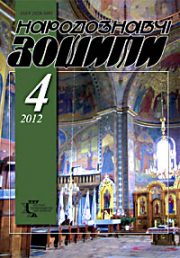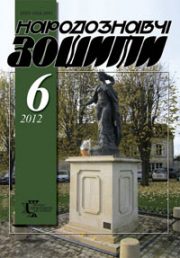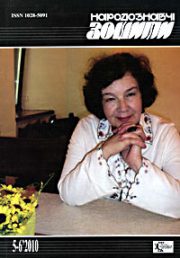The Ethnology Notebooks. 2025. № 4 (184), 865—882
UДК725:719
DOI https://doi.org/10.15407/nz2025.04.865
TARAS Jaroslav
- ORCID ID: https://orcid.org/0000-0001-7241-9466
- Doctorof Sciences in History, prof.,
- Department of Architecture and Restoration,
- Lviv Polytechnic National University,
- 12,S. Bandery Str., 79013,Lviv, Ukraine,
- Contacts: e-mail: etnomod@ukr.net
RATUSHYNSKYJ Nazar
- ORCIDID: https://orcid.org/0000-0002-4837-3274
- Candidate of Architecture, Senior Lecturer,
- Department of Architecture and Restoration,
- Lviv Polytechnic National University,
- 12, S. Bandery Str., 79013,Lviv,Ukraine,
- Contacts: e-mail:nazrat87@gmail.com
Abstract. Uniqueness, in most cases historical and architectural, is of particular importance in the formation of public space. Today’s task is to rethink and interpret it to create demonstration conditions for the presentation of history and architectural value, which will provide the opportunity to create the public space of the future. Passages were an important factor in shaping the modern public space of Lviv, in which there were 15 passages in the central part of Lviv in the inter-quarter spaces, of which only three passages did not lose their original function. All the rest ceased to exist. The passages were important objects of public life in Lviv. The loss of the passages of their original function is associated with the Soviet ideological and political doctrine according to which the necessary condition was the impossibility of public activity and the prevention of political mobilization of the population for certain events. The problem is that the European public center of Lviv was created in the 19th century at the beginning of the 20th century, in which an important place was occupied by passages that served as city-wide recreational, educational and entertainment spaces and had great historical and architectural and artistic significance for the visual presentation of our European identity, were destroyed by the Soviet authorities in order to make any public activity impossible, to prevent public political mobilization of the population. The change of paradigm by the Soviet authorities regarding public spaces led to the passages losing their original function.
Ukraine’s integration into the European community put on the agenda the issue of their reproduction as ethno-identification markers of space, the restoration of our European development and our own identity. Today we need to begin the processes of renovation and revitalization of the passages and at the same time the elimination of the vestiges of Soviet identity that appeared in the spaces of the former passages, in order to return the true values of the environment, restore the historical development of the material and spiritual culture of Lviv in the 19th and early 20th centuries.
The goal is to clarify the genesis of the passages in the context of their place and significance for the formation of the modern public space of Lviv on the basis of the ethno-cultural tradition that developed in the city in the late 19th and early 20th centuries.
The main tasks are to highlight the true history and architectural value of Lviv’s passages for the present, to indicate their importance for the formation of the public space of the city center of the 21st century.
The methodological basis of the study is the principle of historicism in combination with structural and functional analysis and the use of architectural graphics methods
Keywords: Galicia, Lviv, passage, commercial public space.
Received 28.07.2025
REFERENCES
- Bevz, M. Urbanistic transformations of the center of Lviv in the period of the late 18th—19th centuries [in Ukrainian].
- Krypiakevych, I. (2004). Historical passages in Lviv.Apriori: Lviv [in Ukrainian].
- Bevz, M. (2001). Urbanistic phenomenon of Lviv.Postup,54 (712) [in Ukrainian].
- Lemko, I. (2006). War days of Lviv (1939—1944).Postup [in Ukrainian].
- Gishchuk, I. (2006). Andreolli Passage: A look through time. Lvivska Gazeta, 13 (13) [in Ukrainian].
- Owner of the house according to tax lists:
- 1 — Owner according to tax lists 1569 and 1573
- 2 — Owner according to tax lists 1631 and 1662
- 3 — Owner according to tax lists 1767 (TSDIAL. F. 52. Op. 1. Case 770; 777;783;812) [in Polish].
- Kotlobulatova, I. (12.1994—01.1995). Passages of Lviv.Halytska Brama, 4 [in Ukrainian].
- Melnyk, I. (2017). Lviv Passages. Retrieved from: http://zaxid.net/home/showSingleNews.do?lvivski_pasazhi &objectId=1094557] [in Ukrainian].
- Lemko, I. (2008). Sichovych Striltsiv, Kryva Lypa. Bankivska street». Lvivska Gazeta, 145 [in Ukrainian].
- Shyshka, O. (1998). Hetman’s Ramps — Svobody Avenue.Halytska Brama, 2 (38), 3—4 [in Ukrainian].
- Chornovil, I. (2005). Mikolyash Passage. Lvivska Gazeta, 226 (792) [in Ukrainian].
- Melnyk, B.V. (2002).Through the Streets of Ancient Lviv. Lviv: Svit [in Ukrainian].
- Biryulyov, Y. (2005). The Art of Lviv Secession. Center of Europe (Pp. 84—86). Lviv [in Ukrainian].
- Lemko, I. (2009). 1243 Streets of Lviv (1939—2009). Center of Europe [in Ukrainian].
- (1997). Halytska Brama, 1 (25) [in Ukrainian].
- Svidyk, D. (2005). West of the Krakow Gate. Postup. Lviv [in Ukrainian].
- Melnyk, I. (2008). Lviv Streets and Townhouses, Walls, Backstreets, Suburbs and Other Features of the Royal Capital City of Galicia.Center of Europe.Lviv [in Ukrainian].
- Lemko, I. (2007).Zelena Street. Lvivska Gazeta,129 (199) [in Ukrainian].







